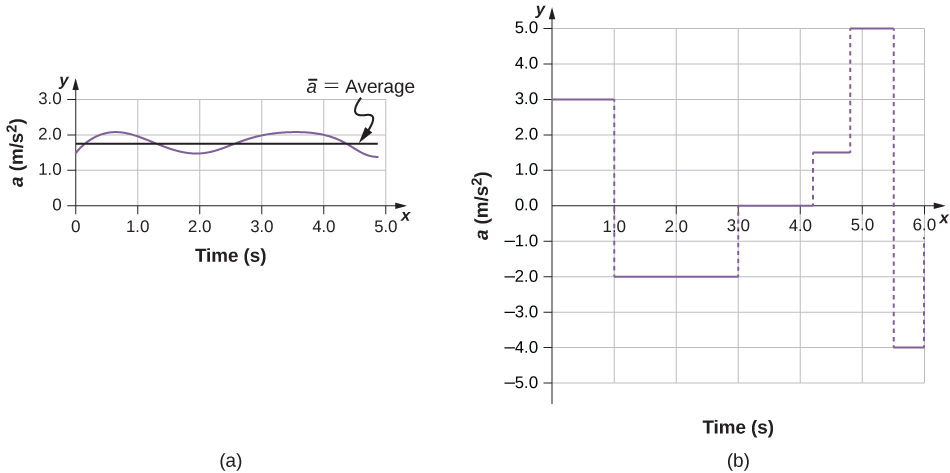| << Chapter < Page | Chapter >> Page > |
| Acceleration | Value (m/s 2 ) |
|---|---|
| High-speed train | 0.25 |
| Elevator | 2 |
| Cheetah | 5 |
| Object in a free fall without air resistance near the surface of Earth | 9.8 |
| Space shuttle maximum during launch | 29 |
| Parachutist peak during normal opening of parachute | 59 |
| F16 aircraft pulling out of a dive | 79 |
| Explosive seat ejection from aircraft | 147 |
| Sprint missile | 982 |
| Fastest rocket sled peak acceleration | 1540 |
| Jumping flea | 3200 |
| Baseball struck by a bat | 30,000 |
| Closing jaws of a trap-jaw ant | 1,000,000 |
| Proton in the large Hadron collider |
In this table, we see that typical accelerations vary widely with different objects and have nothing to do with object size or how massive it is. Acceleration can also vary widely with time during the motion of an object. A drag racer has a large acceleration just after its start, but then it tapers off as the vehicle reaches a constant velocity. Its average acceleration can be quite different from its instantaneous acceleration at a particular time during its motion. [link] compares graphically average acceleration with instantaneous acceleration for two very different motions.

Learn about position, velocity, and acceleration graphs. Move the little man back and forth with a mouse and plot his motion. Set the position, velocity, or acceleration and let the simulation move the man for you. Visit this link to use the moving man simulation.
Is it possible for speed to be constant while acceleration is not zero?
No, in one dimension constant speed requires zero acceleration.
Is it possible for velocity to be constant while acceleration is not zero? Explain.
Give an example in which velocity is zero yet acceleration is not.
A ball is thrown into the air and its velocity is zero at the apex of the throw, but acceleration is not zero.
If a subway train is moving to the left (has a negative velocity) and then comes to a stop, what is the direction of its acceleration? Is the acceleration positive or negative?
Plus and minus signs are used in one-dimensional motion to indicate direction. What is the sign of an acceleration that reduces the magnitude of a negative velocity? Of a positive velocity?
Plus, minus
A cheetah can accelerate from rest to a speed of 30.0 m/s in 7.00 s. What is its acceleration?
Dr. John Paul Stapp was a U.S. Air Force officer who studied the effects of extreme acceleration on the human body. On December 10, 1954, Stapp rode a rocket sled, accelerating from rest to a top speed of 282 m/s (1015 km/h) in 5.00 s and was brought jarringly back to rest in only 1.40 s. Calculate his (a) acceleration in his direction of motion and (b) acceleration opposite to his direction of motion. Express each in multiples of g (9.80 m/s 2 ) by taking its ratio to the acceleration of gravity.
Sketch the acceleration-versus-time graph from the following velocity-versus-time graph.


A commuter backs her car out of her garage with an acceleration of 1.40 m/s 2 . (a) How long does it take her to reach a speed of 2.00 m/s? (b) If she then brakes to a stop in 0.800 s, what is her acceleration?
Assume an intercontinental ballistic missile goes from rest to a suborbital speed of 6.50 km/s in 60.0 s (the actual speed and time are classified). What is its average acceleration in meters per second and in multiples of g (9.80 m/s 2 )?
An airplane, starting from rest, moves down the runway at constant acceleration for 18 s and then takes off at a speed of 60 m/s. What is the average acceleration of the plane?

Notification Switch
Would you like to follow the 'University physics volume 1' conversation and receive update notifications?